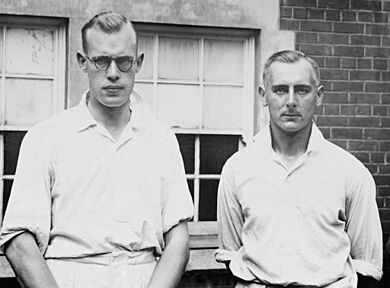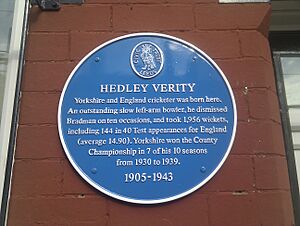Hedley Verity facts for kids
 |
||||||||||||||||||||||||||||||||||||||||
| Personal information | ||||||||||||||||||||||||||||||||||||||||
|---|---|---|---|---|---|---|---|---|---|---|---|---|---|---|---|---|---|---|---|---|---|---|---|---|---|---|---|---|---|---|---|---|---|---|---|---|---|---|---|---|
| Full name |
Hedley Verity
|
|||||||||||||||||||||||||||||||||||||||
| Born | 18 May 1905 Headingley, Leeds, West Riding of Yorkshire, England |
|||||||||||||||||||||||||||||||||||||||
| Died | 31 July 1943 (aged 38) Caserta, Campania, Italy |
|||||||||||||||||||||||||||||||||||||||
| Batting | Right-handed | |||||||||||||||||||||||||||||||||||||||
| Bowling | Slow left-arm orthodox | |||||||||||||||||||||||||||||||||||||||
| Role | All rounder | |||||||||||||||||||||||||||||||||||||||
| International information | ||||||||||||||||||||||||||||||||||||||||
| National side | ||||||||||||||||||||||||||||||||||||||||
| Test debut (cap 262) | 29 July 1931 v New Zealand | |||||||||||||||||||||||||||||||||||||||
| Last Test | 27 June 1939 v West Indies | |||||||||||||||||||||||||||||||||||||||
| Domestic team information | ||||||||||||||||||||||||||||||||||||||||
| Years | Team | |||||||||||||||||||||||||||||||||||||||
| 1930–1939 | Yorkshire | |||||||||||||||||||||||||||||||||||||||
| Career statistics | ||||||||||||||||||||||||||||||||||||||||
|
||||||||||||||||||||||||||||||||||||||||
|
Source: ESPNCricinfo, 1 September 2009
|
||||||||||||||||||||||||||||||||||||||||
Hedley Verity (born 18 May 1905 – died 31 July 1943) was a professional cricket player. He played for Yorkshire and England. His career lasted from 1930 to 1939. Hedley was a slow left-arm orthodox bowler. He took 1,956 wickets in first-class cricket. His average was 14.90 runs per wicket. In 40 Tests, he took 144 wickets. His Test average was 24.37.
In 1932, he was named one of the Wisden Cricketers of the Year. Many people think he was one of the best slow left-arm bowlers ever. He didn't spin the ball a lot. Instead, he was very accurate with his bowling. On pitches that were hard to bat on, especially after rain, he was almost impossible to play against.
Verity was born in Leeds. From a young age, he dreamed of playing cricket for Yorkshire. He became well-known in local cricket. Then he signed a contract to play professionally. He later changed his bowling style to spin. This helped him get a spot in the Yorkshire team. In 1930, he had a successful tryout. He quickly became a top bowler. In 1931, he took all 10 wickets in one innings against Warwickshire. The next year, he did it again against Nottinghamshire. He only gave away 10 runs. This is still a record in first-class cricket. He helped Yorkshire win the County Championship seven times.
In 1931, he first played for England. He became famous during a tour to Australia in 1932–33. He often played for England after that. His best performance was taking 15 wickets against Australia at Lord's in 1934. Some critics said he wasn't good on easy batting pitches. So, he was sometimes left out of the England team. But he had one of the best records against Donald Bradman. Bradman is seen as the greatest batsman ever. Verity played for Yorkshire and England until 1939. His career ended when World War II started.
Verity joined the Green Howards in 1939. He served in India, Persia, and Egypt. He became a captain. In 1943, during the Allied invasion of Sicily, he was badly hurt. He was captured by the Germans. He died from his injuries in Caserta, Italy. He was buried there.
Contents
Becoming a Cricketer
Early Life and Cricket Dreams
Hedley Verity was born in Headingley, Leeds, on 18 May 1905. He was the oldest of three children. His father worked for a coal company. His mother was a Sunday school teacher. The family moved a few times. Hedley loved watching Yorkshire play cricket. He watched games in Leeds, Bradford, and Scarborough.
At school, Hedley played cricket. He bowled medium-paced balls with his left arm. He could make the ball swing both ways. When he was 14, he left school. He worked for his father's coal business. But he spent more and more time practicing cricket. He really wanted to play for Yorkshire.
Getting Noticed
In 1921, Verity played his first league game for Rawdon. He took many wickets. Local newspapers started to notice him. The next year, Yorkshire coaches saw him. George Hirst and Bobby Peel watched him practice. They saw he was smart and controlled the ball well. But they thought he wasn't fast enough for Yorkshire.
Hedley's batting also got better. By 1924, a newspaper called him "one of the most promising cricketers." In 1924, he moved to Horsforth Hall Park. His batting became even stronger than his bowling. In 1926, he scored 488 runs and took 62 wickets. He won a prize for best junior bowler. This showed he was a good all-round player. He got another tryout with Yorkshire.
Joining the Leagues
Yorkshire coach George Hirst was impressed. He suggested Hedley join Accrington Cricket Club. This team was in the Lancashire League. Hedley signed a contract in September 1926.
His first season in 1927 was not good. His bowling wasn't as strong as the club hoped. He didn't take many wickets. His batting average was very low. The more experienced players weren't very helpful. Accrington offered him a new contract. But Hedley said no. They wouldn't let players leave for county cricket.
So, Hedley joined Middleton in the Central Lancashire Cricket League. They paid him less. But they promised to let him play for Yorkshire if he was picked. He worked hard with his younger teammates. He helped them improve their game.
Switching to Spin
Around this time, Hedley visited the Yorkshire practice nets. Wilfred Rhodes, Yorkshire's main spin bowler, was thinking about retiring. Rhodes and Hirst suggested Hedley switch to spin bowling. There were fewer spin bowlers than medium-pace bowlers. This would give him a better chance to join Yorkshire.
Hedley started bowling spin in 1929. He immediately got attention from other counties. He had a tryout with Warwickshire, but it didn't work out. Later that season, he filled in for the Yorkshire Colts team. He took five wickets for only seven runs. By the end of the season, he had taken 100 wickets for Middleton. He was the top bowler in his league.
For the 1930 season, other clubs offered him a lot of money. But Hedley turned them down. He wanted to play for Yorkshire. Middleton let him play for Yorkshire in 1930. They later let him out of his contract. Playing in these leagues made Hedley a very tough and experienced player.
Playing for Yorkshire
First Season with Yorkshire
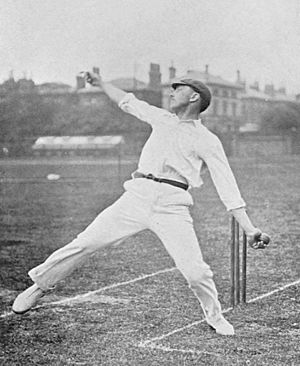
In early 1930, Wilfred Rhodes said he would retire. Yorkshire needed a new spin bowler. George Hirst thought Verity was the best choice. Hedley played his first first-class game on 21 May 1930. It was against Sussex. Rhodes watched him play. He seemed sure Hedley was the right person to replace him.
Hedley took three wickets in the game. The newspapers praised him. They said he stopped batsmen from scoring. He played more games. In his fourth game, he took nine wickets for 60 runs. He took 12 wickets in the whole match. The pitch was wet from rain. This made it hard for batsmen against spin bowlers. After this, Hedley played regularly with Rhodes. He took 64 wickets in 12 games. His average was 12.42 runs per wicket. This made him the top bowler in the country. His best game was against Hampshire. He took 13 wickets for 83 runs.
Rhodes and Emmott Robinson, older players, helped Hedley. They talked about tactics and mistakes. Hedley learned a lot from them. He listened carefully to Rhodes' advice. Even after good games, they would talk about how to improve. By the end of the season, everyone thought Hedley would play for England.
Making His Test Debut
In 1931, many people watched Verity closely. They wanted to see if he was as good as Rhodes. He started well. He took five wickets in Yorkshire's first two games. Then, in his fifth game, he made history. He became only the second player to take all 10 wickets in one innings for Yorkshire. It happened on his 26th birthday against Warwickshire. He took 10 wickets for 36 runs. Yorkshire won the game easily.
A week later, he had a tough game. But the rest of his season was great. Rain often made pitches good for his bowling. He had many strong performances. He was chosen to play for the Players team against the Gentlemen at Lord's. He took five wickets in that game. Yorkshire also gave him his county cap.
England selectors watched him. He took 11 wickets against the touring New Zealand team. So, he was picked for the last two Test matches against New Zealand. He made his Test debut on 29 July 1931. He took four wickets for 75 runs. England won the match. He was kept for the final Test. But rain stopped play, so he didn't bowl. In his first full season, Hedley took 188 wickets. His average was 13.52. He was second in the national averages. Yorkshire won the County Championship. Wisden, a famous cricket book, said Verity was key to their success. He was named one of Wisden's Cricketers of the Year.
Setting a World Record
Yorkshire started the 1932 season poorly. But they improved and won the County title again. Hedley and his teammate Bill Bowes took 352 wickets together. Hedley took 162 wickets at an average of 13.88. He was second in the national averages.
His best game was on 12 July at Headingley. It was the last day of a match against Nottinghamshire. Heavy rain had fallen the day before. The pitch was very difficult for batting. Hedley bowled his first nine overs without giving away any runs. Then, he took all 10 wickets for only 10 runs! He took seven wickets in just 15 balls. This included a hat-trick. His bowling figures of 10 for 10 are still a record. It's the fewest runs given away while taking all 10 wickets in first-class cricket. He is the only Yorkshire bowler to take all 10 wickets twice. Yorkshire won the match easily.
Even with this amazing performance, he wasn't picked for the Test match against India. But his performance helped him get chosen for the 1932–33 Ashes tour to Australia. He was one of the last players added to the team.
International Career
The Bodyline Tour (1932-33)
The England captain, Douglas Jardine, wanted Hedley to bowl carefully. He wanted him to stop batsmen from scoring. This would let the fast bowlers rest. People didn't expect Hedley to do well in Australia. The pitches were good for batting. Australian batsmen were aggressive. But Hedley started the tour well. He took seven wickets for 37 runs against a top Australian team. He even got the wicket of Don Bradman. In the next game, he took eight wickets. The newspapers started to notice him.
He played in the first Test. But he only bowled a few overs. England won the match using "bodyline" tactics. This was a very controversial way of bowling fast at the batsmen's bodies. Hedley was left out of the second Test. But England lost that game.
Hedley returned for the third Test. He helped England with his batting. He scored 45 and 40 runs. He took one wicket, dismissing Bradman. England won the match. Hedley's bowling was best in the final Test. Jardine let him bowl more aggressively. He took three wickets in the first innings. Then he took five wickets for 33 runs in the second. He dismissed Bradman again. He also took two wickets in a row.
In the Test series, Hedley took 11 wickets. His average was 24.65. He was second in the bowling averages. In all first-class games in Australia, he took 44 wickets. His average was 15.86. He was the top bowler for England on the tour. Wisden said he had a "fine bowling record." Jardine wrote that Hedley had a "triumphant" first tour.
Playing Against West Indies (1933)
In 1933, Yorkshire won their third County Championship in a row. Hedley took 190 wickets. His average was 13.43. He was fifth in the national averages. In seven games, he took 10 or more wickets. He also scored over 600 runs, his best batting season so far. He made three half-centuries.
He played in the first two Tests against the West Indies. He took four wickets in the first match. He took seven wickets in the series. He was left out of the final game. But in other games against the West Indies, he took 22 wickets. Against Essex, he set another record. He took 17 wickets in one day. This happened on a pitch damaged by rain.
Touring India (1933-34)
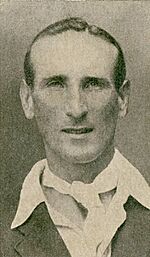
After the West Indies series, Hedley toured India with an England team. Douglas Jardine was captain again. Hedley was the only other player from the Bodyline series to go. Hedley enjoyed the tour. He became good friends with Charlie Barnett. Hedley helped Barnett with homesickness.
Hedley took the most wickets on the tour. He took 72 wickets at an average of 15.54. In one game, he took six wickets for 46 runs. His best figures were seven for 37. He took five wickets in an innings five times. He also scored his highest first-class score of 91 not out.
In the second Test, he took eight wickets. He also scored 55 not out, his first Test half-century. England won the first Test. So, the last match would decide the series. Hedley scored 42 runs. Then he took seven wickets for 49 runs. The Indian batsmen struggled against his accurate bowling. He took four more wickets in the second innings. This gave him 11 wickets in the match. It was his first time taking 10 or more wickets in a Test. In the three Tests, Hedley took 23 wickets. His average was 16.82. He was the top bowler in the series.
Jardine admired Hedley greatly. He once said, "Thank God we have one bowler in the side"—meaning Verity. Jardine thought Hedley was the best slow left-arm bowler ever. He even named his second son Douglas after Jardine.
The 1934 Ashes Series
In 1934, Hedley took 150 wickets. His average was 17.63. He was third in the national averages. Australia toured England that year. Hedley played in all five Test matches. Australia won the first game.
The second match was at Lord's. England scored 440 runs. Australia was doing well at 192 for two wickets. Hedley was the only bowler causing trouble. He caught and bowled Bradman. Then, rain fell overnight. The pitch changed and became helpful for spin. On the third day, Australia lost eight wickets quickly. Hedley took six of them. He finished with seven wickets for 61 runs. Australia had to bat again. Hedley took eight wickets for 43 runs. He dismissed Bradman a second time. He took 15 wickets in the match. Fourteen of those wickets came on the third day. This game became known as "Verity's match." It was the only time England beat Australia at Lord's in the 20th century.
The third match was on a very good batting pitch. England scored 627 runs. Hedley scored 60 not out. He bowled 53 overs and took four wickets. He stopped the batsmen from scoring fast. The match was a draw. The fourth Test was also a draw. Bradman and Bill Ponsford scored many runs. Hedley took three wickets but gave away 113 runs. Australia won the final game. They won the Ashes. Hedley took 24 wickets in the series. His average was 24.00. Wisden said Hedley was steady but not always effective on hard pitches.
Mid-1930s Career
In 1935, Yorkshire won the County Championship again. Hedley took over 200 wickets for the first time. He took 211 wickets at an average of 14.36. He was third in the national averages. He took five wickets in an innings 22 times. He also scored over 600 runs.
South Africa played England in a five-Test series. Hedley played in the first four games. In the first match, he took three wickets for 52 runs. Rain stopped the game. South Africa won the second Test. Hedley took six wickets. In the third and fourth games, he took very few wickets. He was gaining a reputation for not taking wickets on good batting pitches. He was dropped for the last match. Even so, he took 12 wickets in the series. He was England's top bowler.
In early 1936, Yorkshire played three games in Jamaica. Hedley scored 101 runs in one game. This was his only first-class century. He batted aggressively.
In the 1936 English season, Hedley took 216 wickets. This was his highest total ever. His average was 13.18. He was second in the national averages. He also scored 855 runs, his highest total. He played in all three Tests against India. England won the series 1–0. Hedley took 15 wickets. He was England's top bowler. He was chosen to tour Australia again in 1936–37.
Second Tour to Australia (1936-37)
Hedley started the tour well. He took 16 wickets before the Tests. England won the first two Tests. Rain helped them by changing the pitch conditions. In the first match, Hedley took only one wicket. But Wisden praised him. They said he bowled very well and helped other bowlers take wickets. In the second Test, Hedley took three wickets, including Bradman's.
The third Test changed the series. Hedley dismissed Bradman again. England's bowlers did well. Then rain changed the pitch. Australia declared their innings. England also declared, hoping to make Australia bat on a difficult pitch. But the pitch became easier. Australia scored 564 runs. Bradman scored 270. Hedley bowled many overs and took three wickets. Wisden said Hedley kept an excellent length. He didn't let batsmen score easily.
England tried Hedley as an opening batsman in the fourth Test. He scored 19 and 17 runs. But he took no wickets. Australia won the series 3–2. Hedley took 10 wickets in the series. His average was 45.50. Wisden said Hedley did well at keeping runs down.
The 1938 Ashes Series
In 1938, Hedley took 158 wickets. His average was 15.38. He was third in the national averages. Yorkshire won the Championship again. Hedley played in all four Tests against Australia. The series was tied 1–1. In the first match, England scored many runs. Hedley bowled very accurately. But the match was a draw.
In the second match, Hedley took four wickets. He took two wickets quickly. But Australia avoided having to bat again. The match was drawn. The third match was stopped by rain. Australia won the fourth Test. Wisden said the pitch was never easy for batting. They thought Australia won because they had better spin bowlers. Hedley took two wickets. Some thought the England captain, Wally Hammond, didn't use Hedley enough.
The final match at The Oval was played until there was a winner. England scored a record 903 runs. Australia lost badly. Hedley bowled 12 overs and took two wickets. He also helped Len Hutton score 364 runs. This broke the record for the highest individual score in a Test. Hedley stayed with Hutton during breaks. He helped him stay focused. Hedley even arranged for Hutton to relax by the sea. Hutton said he owed Hedley a lot. The series was drawn. Hedley took 14 wickets. His average was 25.28.
Final Seasons (1938-39)
In the winter of 1938–39, Hedley toured South Africa. He took 47 wickets in first-class games. In the Test matches, batsmen played very carefully. Hedley bowled accurately. He played in all five Tests. He took 19 wickets. The first two matches were drawn. England won the third. The fourth was a draw. The final game was played without a time limit. It lasted 10 days! It had to be stopped so the team could catch their boat home. It set a record for total runs scored in a first-class game. Hedley took four wickets. He bowled 766 balls, a new record.
Hedley's last first-class cricket was in 1939. The war was about to start. Yorkshire won their third Championship in a row. Hedley took 191 wickets. His average was 13.13. He was the top bowler in the country. He played in the first Test against West Indies. He took two wickets. He was then left out of the team. His career ended early because of the war. His last match was against Sussex. He took seven wickets for nine runs. Yorkshire won the game. In his career, he took 1,956 wickets. He also scored 5,603 runs.
Bowling Style and Impact
Hedley Verity bowled the ball faster than most spin bowlers. He was tall and strong. His main strength was bowling straight and very accurately. He could make the ball bounce sharply. His best ball curved through the air. It would land on the middle and leg stumps. Then it would spin away from the batsman. This made many batsmen hit the ball to the slips. On wet pitches, he bowled slower. He was almost impossible to bat against then.
Hedley didn't spin the ball very far. He focused on bowling in the right spot. Some critics thought he wasn't dangerous enough. They found him boring to watch. Later in his career, he was known for not taking wickets on good batting pitches. He was sometimes dropped from the England team. But he only missed one Test against Australia and one against South Africa. He thought his good performances on difficult pitches were more important. He once said, "Do not praise me when I have taken 8 for 20 on a sticky wicket, but when I have got 2 for 100 on a perfect wicket."
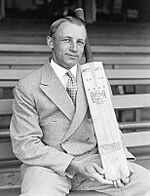
Hedley earned the respect of Donald Bradman. Bradman is considered the greatest batsman ever. Bradman said Hedley was a great cricketer. He respected Hedley as a player and a person. One writer said Hedley was one of the few bowlers who could challenge Bradman. Hedley dismissed Bradman eight times in Tests. This is more than any other bowler. In all first-class cricket, he dismissed Bradman 10 times. Bradman once said, "I think I know all about Clarrie (Grimmett), but with Hedley I am never sure. You see, there's no breaking-point with him."
Many people say Hedley Verity was one of the greatest left-arm spin bowlers. One writer said, "in his own short time, he was the best of his kind." Douglas Jardine thought he was better than any previous Yorkshire spinners. Les Ames, a wicket-keeper, said he was the best left-arm spinner he played against. Bradman believed Hedley was one of the greatest slow left-handed spinners of all time.
As a batsman, Hedley sometimes showed he could be good. He scored one first-class century. But he focused most of his energy on bowling.
Military Service and Death
Joining the Army
Around 1937, Hedley expected World War II to start. He read military books to prepare. He and Bill Bowes decided to join the army together. After a short time in the Royal Engineers, Hedley became an officer. In January 1940, he became a second lieutenant in the Green Howards. He was later promoted to captain.
He trained new soldiers in Richmond, North Yorkshire. In 1941, his battalion moved to Northern Ireland for more training. His Yorkshire teammate Norman Yardley was also there. Their fame as cricketers impressed the local people. Hedley played cricket matches and took many wickets. He even played in a charity match at Lord's. In August, he returned to England. Then he was sent overseas.
Serving Overseas and Final Days
In early 1942, Hedley's battalion went to India. The climate made him sick. He suffered from dysentery. Doctors wanted to send him home. But he stayed with his unit. By the end of the year, his battalion went to Persia (now Iran). In March 1943, they moved to Egypt for training. Then they went to Syria. They were getting ready for the Allied invasion of Sicily.
Hedley was not at his best fitness. He was also getting older. His commanders planned to move him to a safer job after the Sicily campaign.
The invasion of Sicily started well. But German forces fought hard near Catania. Hedley's company was surrounded in a night attack on 19 July. Hedley was hit in the chest by shrapnel. He was badly wounded. His company had to leave him behind when they retreated. His last order was "keep going."
The Germans captured Hedley. He was taken to a hospital and had an operation. He was moved by boat to Italy. Then he traveled by train to Naples. The German hospital was full. So, Hedley was sent to an Italian hospital in Caserta. He was very ill. He had another operation to help his lung. The operation seemed to work. But Hedley got worse quickly. He bled heavily. He died on 31 July 1943. He was buried with full military honors. His grave was later moved to a military cemetery.
Don Bradman wrote that Hedley never complained. He said Hedley kept this attitude until the very end. After the war, Yorkshire held a memorial match for Hedley. Later, some Yorkshire players visited his grave. Members of an England team also paid tribute there.
Personal Life
Hedley Verity married Kathleen Alice Metcalfe on 7 March 1929. They had known each other since they were children. They had two sons. Their first son, Wilfred, was named after Wilfred Rhodes. Their second son, George Douglas, was named after George Hirst and Douglas Jardine.
Before the war, Kathleen Verity was not well. The family planned a trip to South Africa. Hedley had job offers there. This trip would help Kathleen recover. It was also a chance for Hedley to coach. In the last months before Hedley went overseas, Kathleen joined him in Omagh and London.
A pub in Leeds city center is named "The Hedley Verity." There is also a Blue plaque on the house where he was born.


